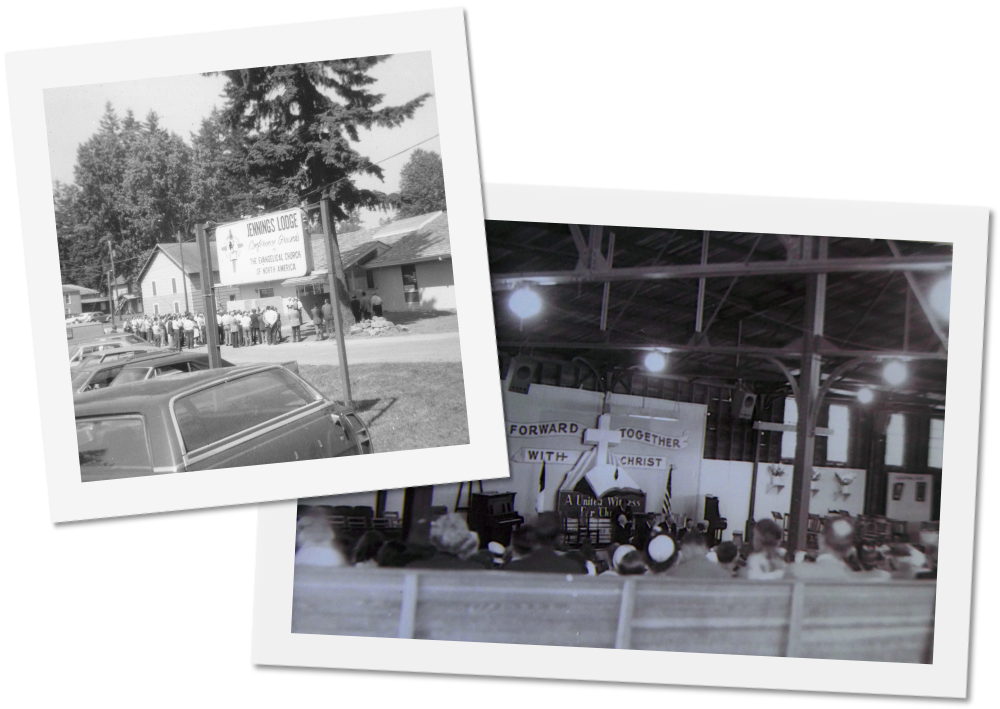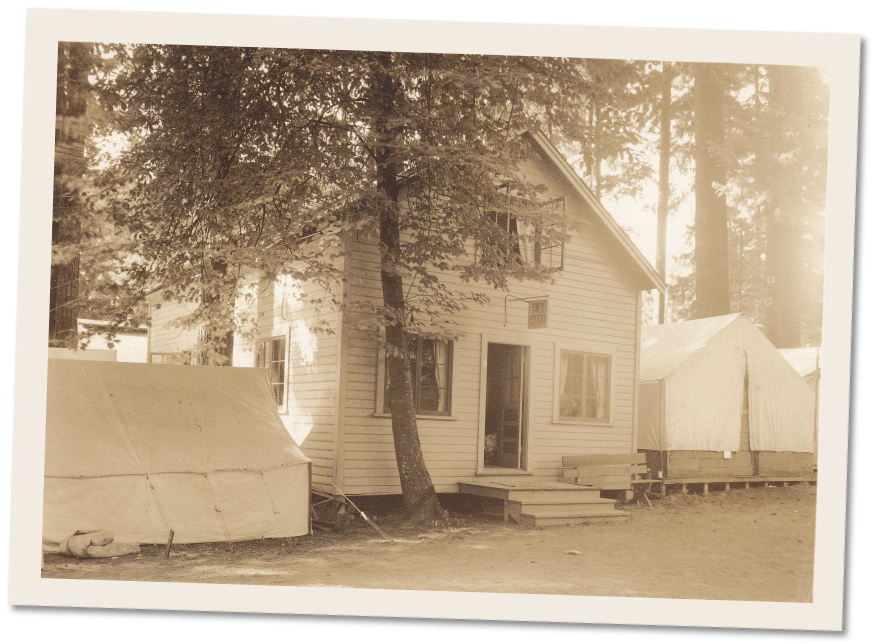
The Jennings Lodge Story
The story of the Jennings Lodge campground began in the Oregon wilderness, though in some ways its inception can be tied to movements that began many years before the land was platted. The Camp Meeting movement, which encouraged outdoor gatherings for Protestant religious services, gained popularity in America in the 1800’s. In the early 1900’s the Chautauqua movement, which focused on adult outdoor education and recreation, also became popular. It was in this social climate that the Camp Meeting society purchased the property for what would become the Jennings Lodge Campgrounds in 1905.
Enlightenment in the Outdoors
Both the Chautauqua and Camp Meeting Movements were popular in rural America and brought people together outdoors for educational and communal experiences. Camp meetings, starting in the late 1700s, focused on intense religious revival and personal faith. Chautauqua, which began in the late 1800s, was more about broad educational and cultural enrichment. Camp meetings were emotionally charged while Chautauqua was aimed at intellectual growth and self-improvement.
“There wasn't much social life on the farm... The churches didn't have any young people... The only social thing about the church was the Camp Meetings. That was where most of the courting was done. When a boy would get old enough for a wife, the father would let him use the horse and buggy for a trip to the camp meeting to Jennings Lodge Camp, get him a wife...”
- Nettie Spencer, interview from American Life Histories: Manuscripts from the Federal Writers’ Project, 1936 to 1940

TIMELINE 1847 - 1905
-
Jennings comes to Oregon 1847Pioneer Berryman Jennings emigrates to Oregon, claiming a plot of land along the Willamette River.
-
Jennings children inherit property 1900Martha Jennings, wife of Berryman Jennings, dies, leaving the couple's land to their children: daughter Addie C. Hodgkins, and sons William B. Jennings and John F. Jennings.
-
Railway Opens 1893East Side Electric Railway opens from Portland to Oregon City with stops in Jennings Lodge. This increases interest in the area's development, and a small community begins to thrive there.
-
First usage of "Jennings Lodge" 1895The first usage of "Jennings Lodge" to describe the community is used in the Oregonian newspaper.
-
Church purchases property 1905Addie Hodgkins sells ten acres of her family's property to the Campmeeting Society, led by Reverend Noah Shupp. The Campmeeting Society holds their first camp meeting on the grounds on August 4th, 1905.

Camp Meetings Today
In 1900, it has been estimated that 1,500 to 2,000 camp meetings took place annually in the United States. By 1998, the number was estimated to be around 1,500 annual camp meetings that were still active. Today, camp meetings are lively events that bring people together for worship, community, and tradition. These gatherings attract individuals from different backgrounds and often include sermons, music, and fun activities held outdoors. Modern camp meetings focus on spiritual renewal and building connections just like they did in the 19th and 20th centuries. They also encourage cooperation among different Christian groups, promoting a shared mission of faith. This tradition shows how early revival movements continue to shape our communities today.
Finding Home in the Outdoors
While Jennings Lodge began expanding with more permanent structures beginning in the 1920’s, campground attendees still often found themselves “roughing it” it in the outdoors. Tents, campers, and cots were common dwellings, and the risk of being subjected to the elements was ever present. Still, many former camp-goers have fond memories of these experiences at Jennings Lodge.
“During the campground [meetings] when they had their sessions going, they had all these kind of, I wouldn’t call them portable, but temporary wooden structures, and they would put canvas over the top and put beds and bedsprings in them, kind of like cots. When they would take them down when the camp meetings were over, they would take down the bedding and the canvas tops and store them in the Mizpah and so there were big stacks of mattresses in there. We actually broke into the building and we would climb around in the rafters and dive off the rafters onto the mattresses. We had a great time in there. It was like our own playground in there; the same thing was true for the whole campground.”
- Stephen Loaiza, from an oral history interview, conducted November 14, 2014

TIMELINE 1920 - 1954
-
Campground expands 1920'sThe Jennings Lodge campground is expanded with permanent and semi-permanent buildings, including dormitories, bathhouses, and a dining hall. Luckel Auditorium (later Millen Auditorium), formerly a racetrack grandstand, is floated down the Willamette River and installed in 1926.
-
Growth after wartime 1945The campgrounds are expanded further, adding the Opal Scheuerman Memorial Building, Friesen Chapel, and Keller Dining Hall to the site.
-
Western Evangelical Seminary founded 1920'sThe Western Evangelical Seminary opens and more dormitories and educational facilities are constructed to accomodate all-year attendance.
-
Jennings Lodge camp attendance peaks 1954The campgrounds achieve a record for number of attendees, reporting a gathering of 2,500 individuals at one time.
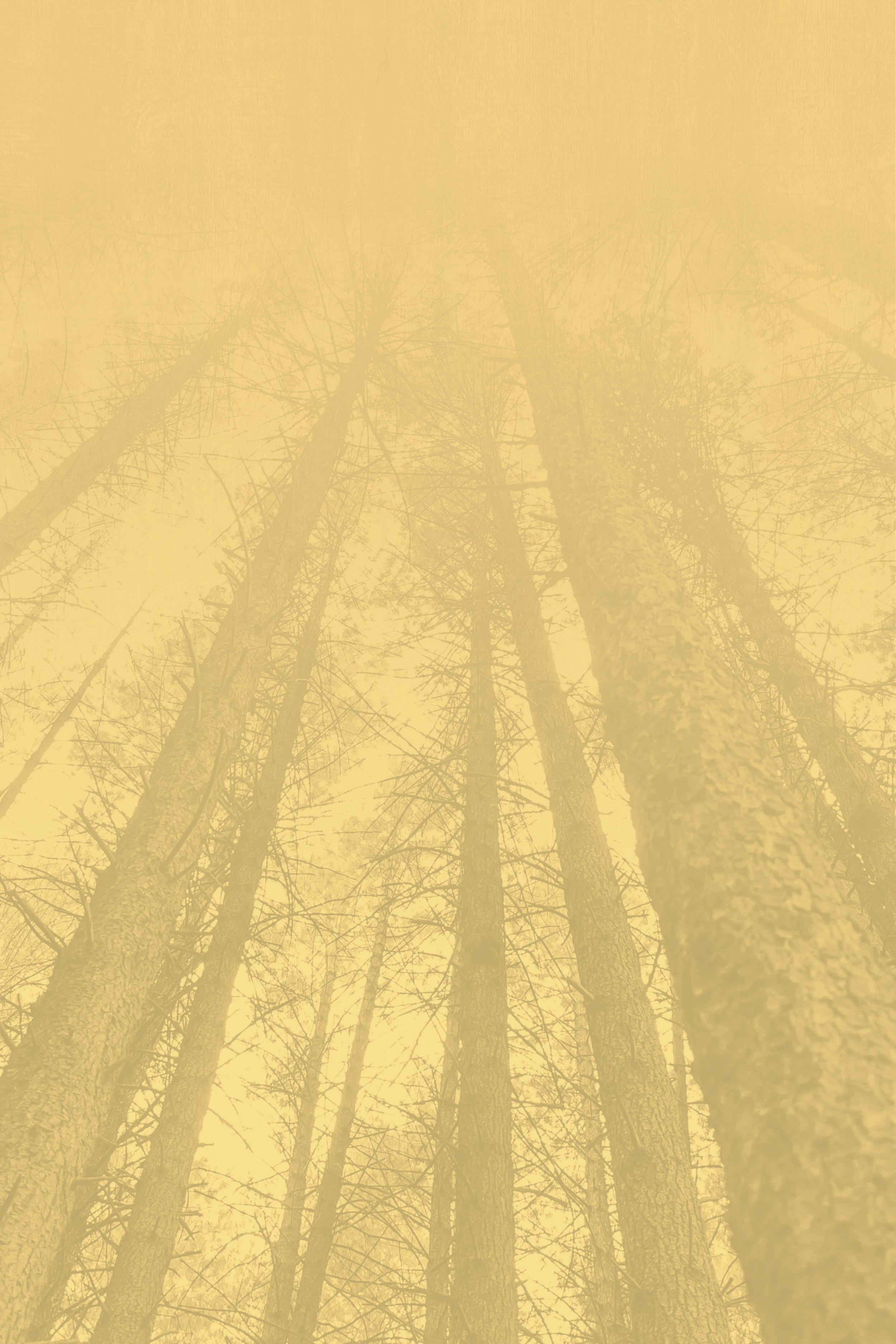
Jennings Lodge Camp: The Later Years
Attendance at Jennings Lodge Camp increased over the years, reaching a peak of 2,500 in 1954. By 1983, a resurgence brought an estimated 10,000 attendees, but by the late 1980s, reports about the camp had faded. The camp's use declined in the 1990s, and many buildings were abandoned, but its impact on faith, community, and education made Jennings Lodge a key chapter in the history of the Evangelical Church.
Echoes of Faith: The Spiritual Legacy of Jennings Lodge Camp
Founded in 1905, Jennings Lodge Camp was a gathering place for over 100 years, becoming Oregon's second-oldest operating camp meeting and one of the oldest in the U.S. Led by the Evangelical Church, it offered a rural retreat for city dwellers from Portland and beyond.
Camp meetings at the Jennings Lodge Camp gave attendees renewed courage to return to their daily lives. After attending a camp meeting, Keturah Belknap wrote in her diary, “We will go home with renewed courage and take up the busy cares of life again, but we feel that we have gained so much strength ... [and] Spirituality that the burdens of life See[m] lighter... “

TIMELINE 1980 - 2014
-
Attendance declines 1980'sDespite a brief resurgence, attendance at the Jennings Lodge campgrounds declines throughout the 1980's and through the 1990's. Several buildings are unable to be maintained and are subsequently abandoned. During this time, use of the property is opened up to other organizations like the Boy Scouts of America and the Head Start program.
-
Jennings Lodge campground closes 2013The decision is made by organization leaders to permanently close the Jennings Lodge campgrounds and the Evangelical Retreat Center.
-
New development 2014Lennar Homes purchases the site and proposes a new housing development on the former campgrounds.
Photo: Friesen Chapel. Image Credit: Lennar (Oak Lodge Library).
The Growth of Jennings Lodge Camp
The following is an interactive map showcasing the growth of Jennings Lodge Camp over the decades. Use the navigational arrows to the left and right to go backwards and forwards in time.
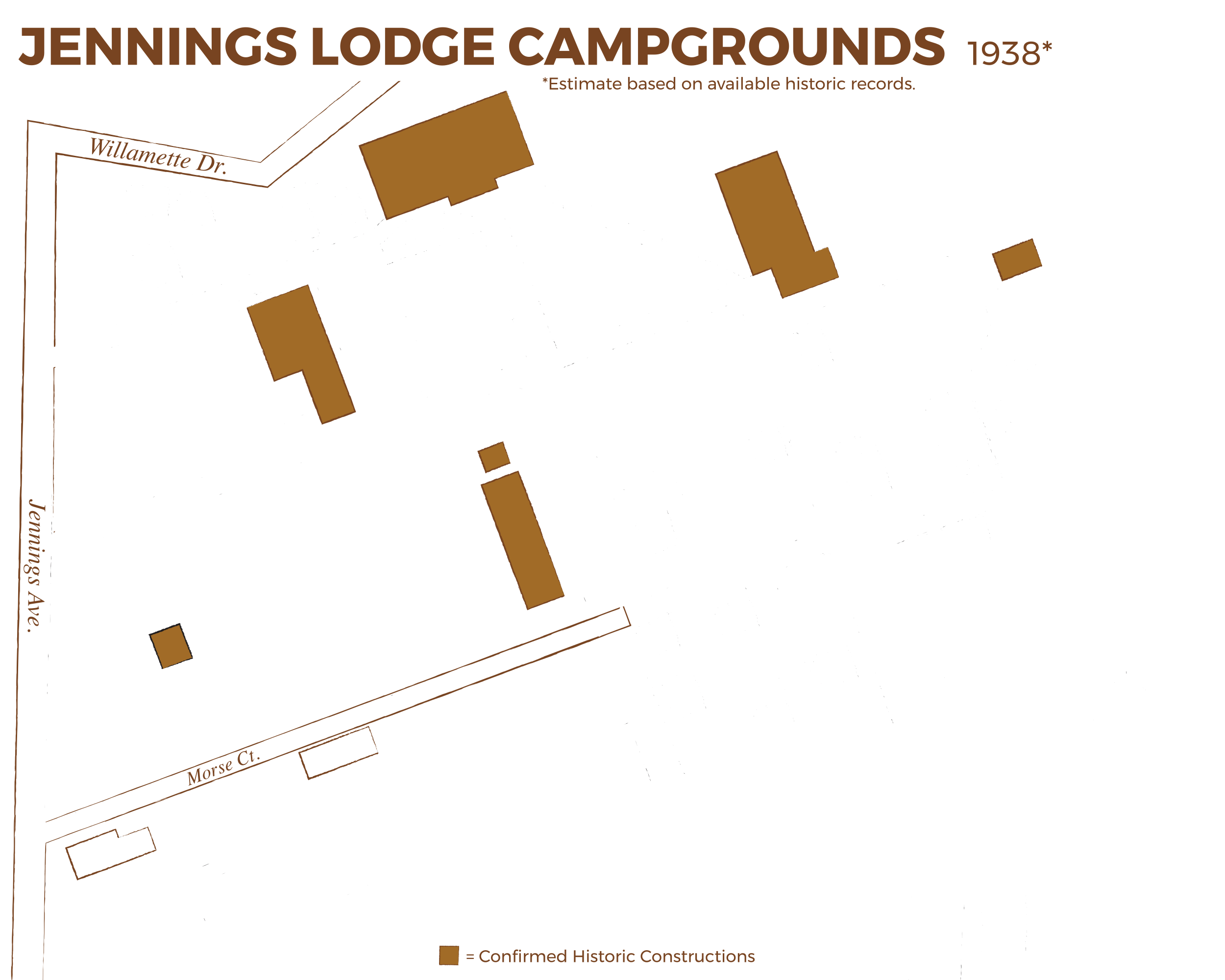
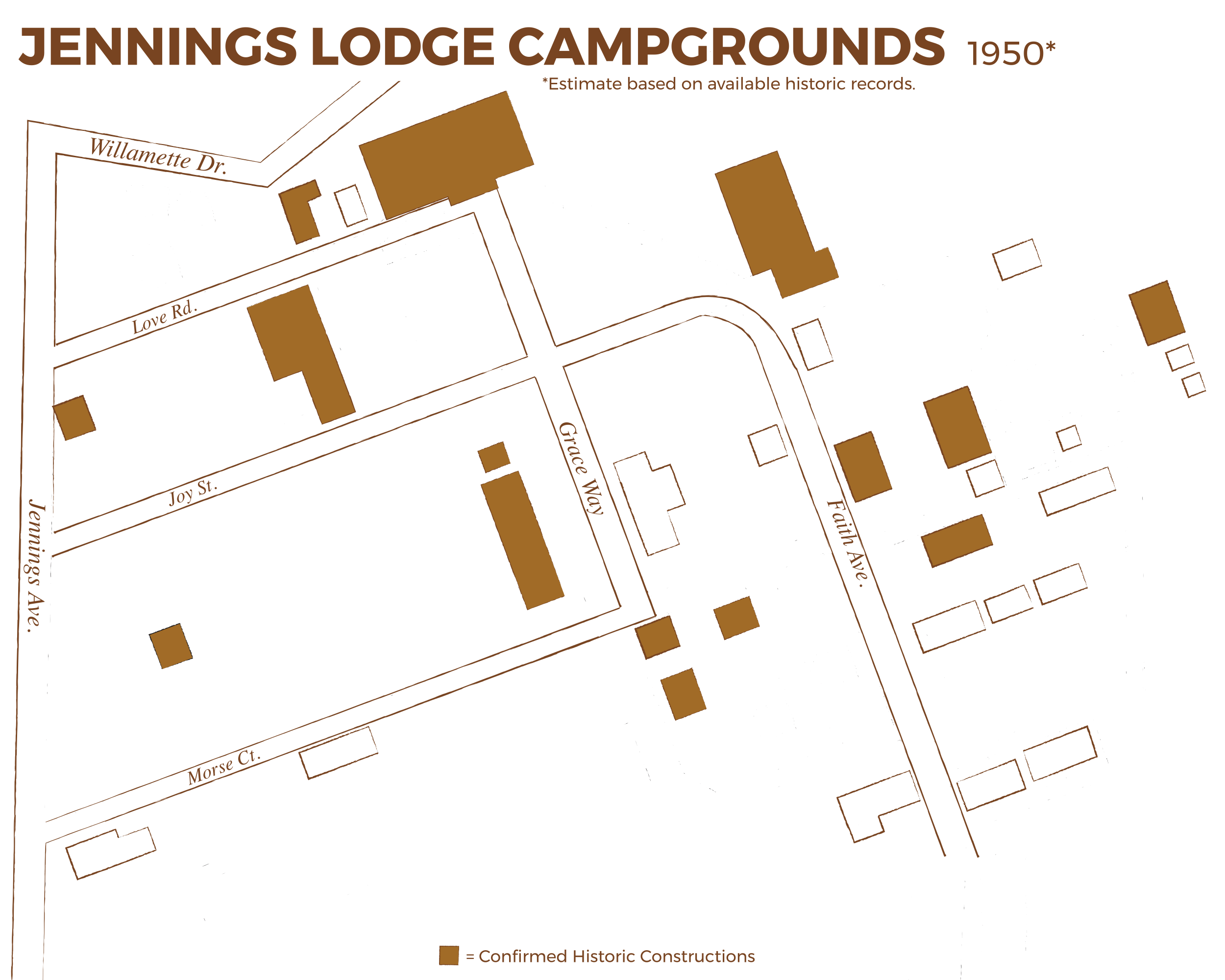
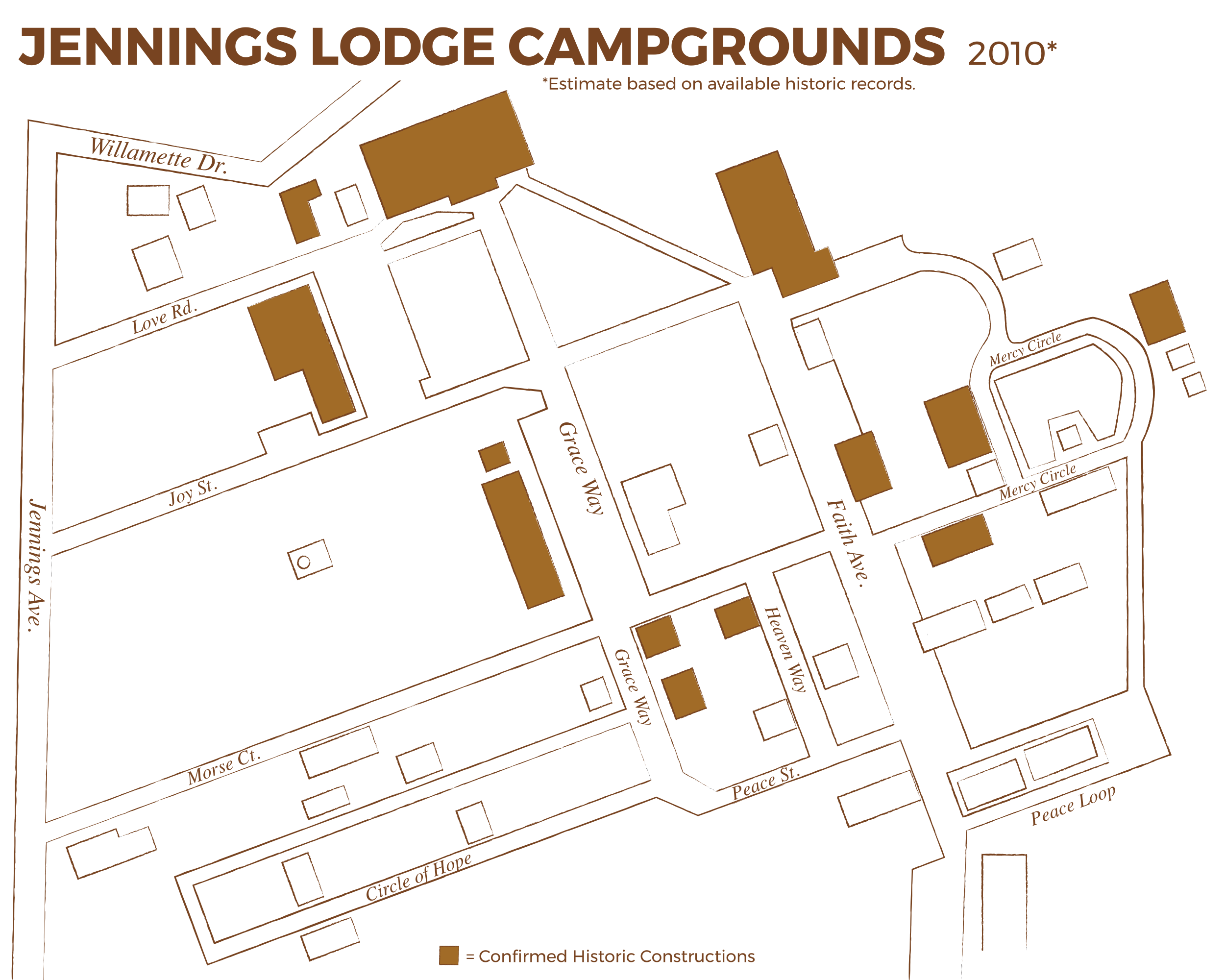

Scouting and Organized Camping Across Oregon
Beyond Jennings Lodge Camp, Oregonians have marveled at the state’s natural beauty for generations. Wilderness and outdoor retreats for people of all ages, denominations, and identities have sprung up throughout Clackamas County, each connected by an appreciation of the natural world.
Girl Reserves and YWCA Camp Westwind
With roots in evangelicalism and the growth of the middle class, the Young Women’s Christian Association began in the 19th century to promote Christian values, spread the Gospel, and support social causes. In 1918, the YWCA launched its Girl Reserves to support young women aged 12-18 during World War I. In Oregon, the program flourished through neighborhood and school-based clubs, fostering female solidarity, Christian faith, and civic engagement. Girl Reserves clubs provided guidance on various topics, from Bible study to career advice.
Starting in 1936, the YWCA offered education programs at Camp Westwind for the Girl Reserves focused on leadership, outdoor skills, and environmental awareness with activities that included exercise, hiking, and horseback riding.
Boy Scouts of America
Founded in 1910, Boys Scouts of America (now Scouting America), with the intent to instill leadership, good citizenship, and independence in young boys through guided outdoor experiences. The founding of the modern scouting movement has been attributed to Lord Robert Baden-Powell of England who, in 1908, released the book “Scouting for Boys,” which then led him to become the founder of the Boy Scouts and the co-founder of the Girl Guides. In Oregon, camps like Camp Millard in Clackamas County, Camp Chinidere in the Mount Hood National forest, and Camp Meriwether on the northern Oregon coast, gave young boys an opportunity to connect with nature and build independence.
Camp Fire Girls Camps
For over a century, Camp Fire has helped young people build leadership skills, learn about the outdoors, and develop a deep love for nature at Camp Namanu and Camp Onahlee. Activities such as archery, arts and crafts, canoeing, hiking, historical reenactments, swimming, and weaving taught girls’ self-reliance and teamwork. Founded as a sister organization to the Boy Scouts, Camp Fire focused on character-building and social responsibility, shaping generations of young leaders.
“Is it any wonder that I grew up believing that all people should be treated equally, that you should appreciate nature, that you should cherish each moment, and be cheerful and kind to everyone? Anyone who doubts the potential impact of a week (or in my case seven) of summer camp on a person’s life has not been to a really good camp.”
- Pam Hembree Bierly, former Camp Fire Girl
Additional Resources







